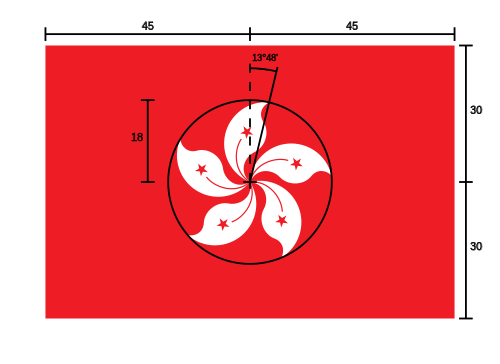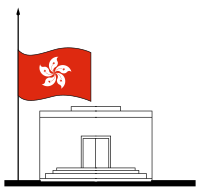Flag of Hong Kong
The Regional Flag of the Hong Kong Special Administrative Region of the People's Republic of China depicts a white stylised five-petal Hong Kong orchid tree (Bauhinia × blakeana) flower in the centre of a Chinese red field.
[1][2] The current design was approved on 10 August 1996 at the Fourth Plenum of the Preparatory Committee of the Hong Kong Special Administrative Region.
[3] The precise use of the flag is regulated by laws passed by the 58th executive meeting of the State Council held in Beijing.
The position of red and white on the flag symbolises the "one country, two systems" political principle applied to the region.
The Chinese name of Bauhinia × blakeana is most commonly rendered as "洋紫荊" (yáng zǐ jīng), but is often shortened to 紫荊 / 紫荆 (zǐ jīng) in official uses since "洋" (yáng) means "foreign" in Chinese, notwithstanding 紫荊 / 紫荆 refers to another genus called Cercis.
The design implies that Hong Kong is an inalienable part of China and prospers in the embrace of the motherland.
The five stars on the flower symbolise the fact that all Hong Kong compatriots love their motherland, while the red and white colours embody the principle of "one country, two systems".
[15] An exception to this rule occurs during medal presentation ceremonies at multi-sport events such as the Olympics and Asian Games.
[21] The Hong Kong flag must be lowered to half-mast as a token of mourning when any of the following people die:[16] The flag may also be flown at half-mast when the Central People's Government advises the Chief Executive to do so, or when the Chief Executive considers it appropriate to do so, on occurrences of unfortunate events causing especially serious casualties, or when serious natural calamities have caused heavy casualties.
In stipulations made in 1997, the Chief Executive further specified that the use of the flag in "any trade, calling or profession, or the logo, seal or badge of any non-governmental organisation" is also prohibited unless prior permission was obtained.
The Court of Appeal overturned the verdict, ruling that the ordinances were unnecessary restrictions on the freedom of expression and in violation of both the Basic Law and the International Covenant on Civil and Political Rights.
He was convicted of three counts of desecrating the flag—for two incidents on 1 July 2000 during the third anniversary of Hong Kong's handover to China and for one incident on 9 July of the same year during a protest against elections to choose the Election Committee, the electoral college which chooses the Chief Executive of Hong Kong.
[27] Prior to the secession of Hong Kong to the United Kingdom following the First Opium War via the Treaty of Nanking, Hong Kong fell under the jurisdiction of the Chinese government and flew the flag and ensign of the Chinese government of the time.
The flag itself features the "Azure Dragon" on a plain yellow field with the red flaming pearl of the three-legged crow in the upper left corner.
[31] On 3 July 1869, a new design for the Hong Kong flag was commissioned at a cost of £3, which featured a "gentleman in an evening coat who is purchasing tea on the beach at Kowloon".
[32] In 1870, a "white crown over HK" badge for the Blue Ensign flag was proposed by the Colonial Secretary.
In 1876, the "local scene" badge (Chinese: 阿群帶路圖 Picture of "Ar Kwan" Guiding the British soldier) was re-adopted to the Blue Ensign flag with the Admiralty's approval.
[33] The flag which was eventually adopted featured the Blue Ensign together with a "local scene" of traders in the foreground and both European-style and Chinese-style trading ships in the background.
During the occupation, the Japanese military government used the flag of Japan in its official works in Hong Kong.
[37] Architect Tao Ho was chosen as one of the panel judges to pick Hong Kong's new flag.
He recalled that some of the designs had been rather funny and with political twists: "One had a hammer and sickle on one side and a dollar sign on the other.

 Original design of the regional flag of Hong Kong revealed in 1990 by the National People Congress
Original design of the regional flag of Hong Kong revealed in 1990 by the National People Congress



